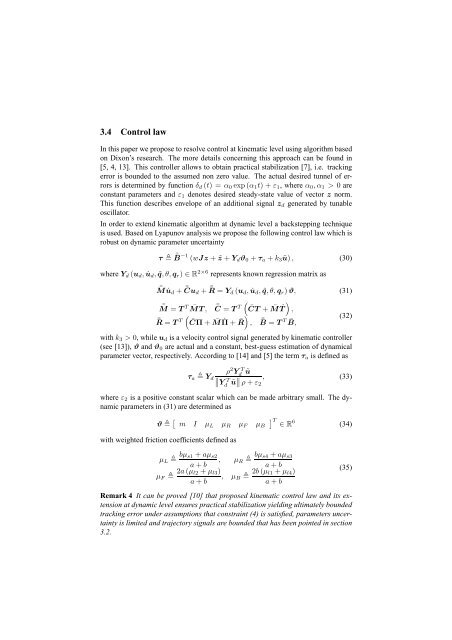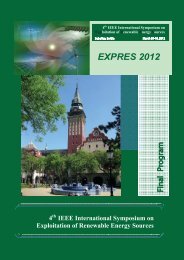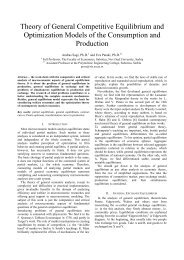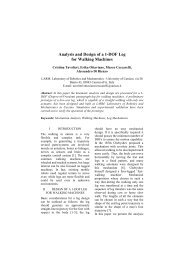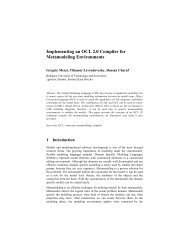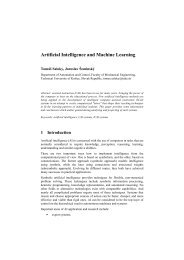Modeling and control of a 4-wheel skid-steering ... - University of Haifa
Modeling and control of a 4-wheel skid-steering ... - University of Haifa
Modeling and control of a 4-wheel skid-steering ... - University of Haifa
Create successful ePaper yourself
Turn your PDF publications into a flip-book with our unique Google optimized e-Paper software.
3.4 Control law<br />
In this paper we propose to resolve <strong>control</strong> at kinematic level using algorithm based<br />
on Dixon’s research. The more details concerning this approach can be found in<br />
[5, 4, 13]. This <strong>control</strong>ler allows to obtain practical stabilization [7], i.e. tracking<br />
error is bounded to the assumed non zero value. The actual desired tunnel <strong>of</strong> errors<br />
is determined by function δ d (t) = α 0 exp(α 1 t) + ε 1 , where α 0 ,α 1 > 0 are<br />
constant parameters <strong>and</strong> ε 1 denotes desired steady-state value <strong>of</strong> vector z norm.<br />
This function describes envelope <strong>of</strong> an additional signal z d generated by tunable<br />
oscillator.<br />
In order to extend kinematic algorithm at dynamic level a backstepping technique<br />
is used. Based on Lyapunov analysis we propose the following <strong>control</strong> law which is<br />
robust on dynamic parameter uncertainty<br />
τ ¯B−1 (wJz + ˜z + Y d ϑ 0 + τ a + k 3 ũ) , (30)<br />
where Y d (u d , ˙u d , ˜q,θ,q r ) ∈ R 2×6 represents known regression matrix as<br />
¯M ˙u d + ¯Cud + ¯R = Yd (u d , ˙u d , ˜q,θ,q r ) ϑ, (31)<br />
( )<br />
¯M = T T ¯MT, ¯C = T<br />
T ¯CT + ¯M T˙<br />
,<br />
(<br />
¯R = T T ¯CΠ + ¯M ˙Π + ¯R<br />
)<br />
(32)<br />
, ¯B = T<br />
T ¯B,<br />
with k 3 > 0, while u d is a velocity <strong>control</strong> signal generated by kinematic <strong>control</strong>ler<br />
(see [13]), ϑ <strong>and</strong> ϑ 0 are actual <strong>and</strong> a constant, best-guess estimation <strong>of</strong> dynamical<br />
parameter vector, respectively. According to [14] <strong>and</strong> [5] the term τ a is defined as<br />
ρ 2 Yd T<br />
τ a Y ũ<br />
d<br />
∥ Y<br />
T<br />
d ũ ∥ , (33)<br />
ρ + ε2<br />
where ε 2 is a positive constant scalar which can be made arbitrary small. The dynamic<br />
parameters in (31) are determined as<br />
ϑ [ m I µ L µ R µ F µ B<br />
] T<br />
∈ R<br />
6<br />
(34)<br />
with weighted friction coefficients defined as<br />
µ L bµ s1 + aµ s2<br />
, µ R bµ s4 + aµ s3<br />
a + b<br />
a + b<br />
µ F 2a(µ l2 + µ l3 )<br />
, µ B 2b(µ l1 + µ l4 )<br />
a + b<br />
a + b<br />
Remark 4 It can be proved [10] that proposed kinematic <strong>control</strong> law <strong>and</strong> its extension<br />
at dynamic level ensures practical stabilization yielding ultimately bounded<br />
tracking error under assumptions that constraint (4) is satisfied, parameters uncertainty<br />
is limited <strong>and</strong> trajectory signals are bounded that has been pointed in section<br />
3.2.<br />
(35)


